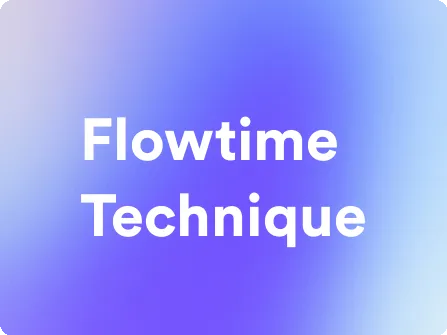What is the Flowtime Technique?
This guide will walk you through the essential elements of using flowtime technique - the productivity method to keep your team productive and engaged.
Try Lark for Free
The flowtime technique is a modern approach to time management that emphasizes maximizing productivity and efficiency through a strategic allocation of time and resources. Unlike traditional methods, the flowtime technique focuses on achieving a state of flow where individuals experience heightened focus and productivity. This technique is rooted in the philosophy that by optimizing workflow and minimizing distractions, individuals can accomplish tasks with greater efficacy and satisfaction.
Origin and Evolution of the Flowtime Technique
The concept of flow and its application to time management can be traced back to the pioneer of positive psychology, Mihaly Csikszentmihalyi, who first introduced the term "flow" in the 1970s. Over time, the principles of flow were integrated into various disciplines, including productivity science and personal development. As a result, the flowtime technique emerged as a contemporary adaptation of these concepts, combining the essence of flow with practical strategies for efficient time utilization. The evolution of this technique has been shaped by insights from cognitive psychology, behavioral economics, and advancements in digital tools, culminating in a comprehensive approach to enhancing productivity.
Target Audience for the Flowtime Technique
The flowtime technique is ideally suited for knowledge workers, entrepreneurs, creative professionals, and individuals seeking to optimize their time utilization and accomplish tasks with heightened efficiency. It caters to individuals and organizations striving to combat common productivity pitfalls such as procrastination, multitasking, and time wastage. Additionally, it extends to various industries and professions, from software development and marketing to academic research and business management, offering versatile applications across diverse work environments.
Use Lark to unleash your team productivity.
Pros and Cons of the Flowtime Technique
Pros
- Facilitates deep focus and engagement with tasks, leading to heightened performance
- Promotes a sense of accomplishment and satisfaction through efficient task completion
- Encourages continuous improvement in time management skills and workflow optimization
- Enhances creative thinking and problem-solving abilities by minimizing distractions
Cons
- May require a period of adjustment for individuals accustomed to traditional time management approaches
- Overemphasis on flow may lead to neglect of necessary breaks and overall well-being
- Striking a balance between flow and flexibility can be challenging in dynamic work environments
- Not universally applicable, as individuals with highly structured roles may find it less compatible
Getting Started with Flowtime Technique
Embracing the Flow Mindset
To begin your journey with the flowtime technique, it's essential to adopt a mindset focused on optimizing productivity and embracing the principles of flow. Acknowledge the significance of uninterrupted focus and its impact on task completion.
Define Productive Parameters
Identify the specific parameters that contribute to your productivity, such as optimal working hours, conducive environments, and tools that aid concentration. Understanding these parameters is crucial for aligning your workflow with the flowtime technique.
Implementing Time Blocks
Allocate dedicated time blocks for tasks, ensuring that each activity aligns with your peak productivity periods. Through intentional scheduling, individuals can enhance their efficiency and task execution.
Minimize Distractions
Efficiently managing distractions is imperative in cultivating flow. By employing strategies to minimize interruptions – from digital detoxes and workspace optimization to setting focused work intervals – individuals can effectively immerse themselves in their tasks.
Examples of the Flowtime Technique in Action
Example 1: Application of Flowtime Technique in Project Management
A project manager sought to enhance team productivity and task management by implementing time blocks aligned with the flowtime technique. By integrating focus-oriented work sessions and deliberate task allocation, the team observed a significant improvement in project timelines and overall efficiency.
Step-by-Step Guide for Implementing Flowtime Technique
Analyze Current Workflow
Begin by assessing your existing workflow and identifying areas where the application of the flowtime technique can yield the greatest impact. Understanding your current productivity patterns is essential for devising targeted strategies.
Create Task-Specific Time Blocks
For each major task or activity, allocate dedicated time blocks, ensuring that the duration aligns with your optimal productivity periods. Tailoring time blocks to specific tasks enhances focus and minimizes potential distractions.
Prioritize Deep Work Sessions
Incorporate extended periods of deep work, during which you immerse yourself in critical tasks without interruptions. This allows for sustained focus and the cultivation of flow.
Review and Adapt
Regularly evaluate the effectiveness of your flowtime technique implementation. Adjust time blocks and strategies based on your evolving workflow and productivity insights.
Learn more about Lark x Productivity
Actionable Tips for Effective Utilization
- Establish Rituals: Implement pre-task rituals or habits that signal the start of focused work sessions, such as setting a specific workspace ambiance or engaging in brief mindfulness exercises.
- Leverage Technology: Utilize productivity-enhancing tools and apps that support the flowtime technique, from time-tracking software to distraction-blocking applications.
- Adapt to Personal Rhythms: Tailor your time blocks and workflow adjustments to align with your individual energy levels and cognitive rhythms, optimizing productivity in accordance with your innate patterns.
Use Lark to unleash your team productivity.
Do's and Dont's of Flowtime Technique
| Do's | Dont's |
|---|---|
| Set clear objectives for each task | Neglect the need for periodic breaks |
| Optimize your workspace for focus | Overcrowd your schedule with excessive time blocks |
| Regularly reassess and refine | Forcefully push through mental fatigue |
| Embrace flexibility within structure | Underestimate the importance of task prioritization |
Conclusion
In conclusion, the flowtime technique stands as a transformative approach to time management, offering individuals and organizations a holistic framework for maximizing productivity and achieving a profound sense of flow. By integrating the principles of flow into daily workflows and prioritizing focused, immersive work sessions, individuals can harness their full potential and realize significant advancements in task performance. Embracing the concept of flow within the context of time management equips individuals with the tools to navigate complex work environments, overcome productivity challenges, and ultimately thrive in their pursuits.
